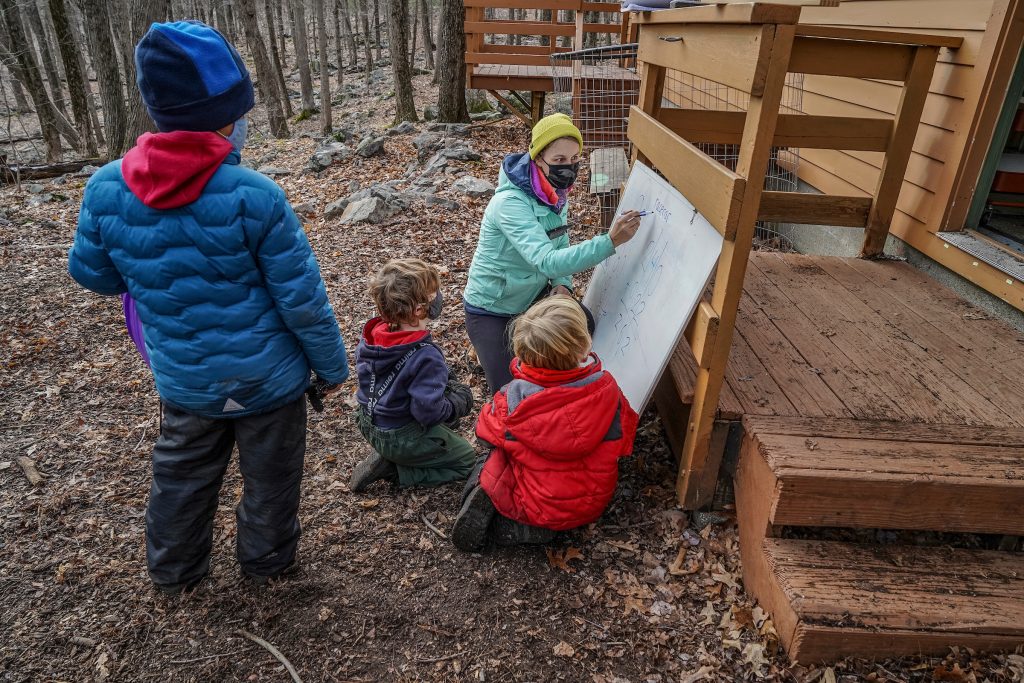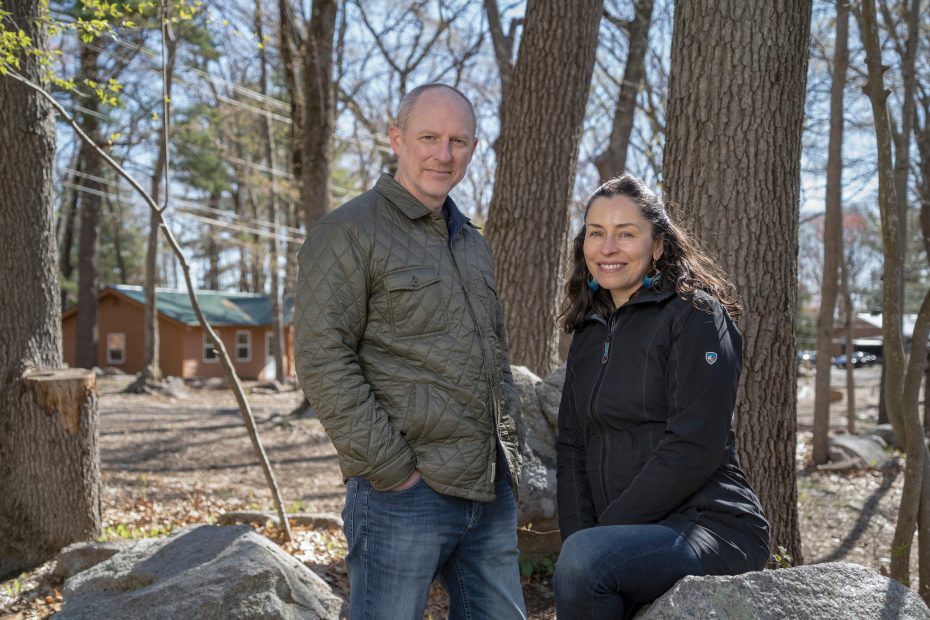By Amy and Dan Warren
Images by Jodi Hilton
Our son, Lio, hops in the car at the end of a cold and damp school day. Rosy-cheeked and smeared with earth and ash from fort-building and fire-making, he reaches down to take off his boots and empty them of leaves, water, and mud. His pockets carry the day’s found treasures: Quartz rocks, cool sticks that double as swords, acorns with their cupule caps carefully removed. He tells us about playing in the stream, falling in, and then warming up by the fire. The cold and wet, and the restorative warmth of fire, are intimate experiences for Lio, part of his personal history. Consequences—the interplay of these experiences—are naturally rooted in the context, and so they are predictable and seemingly just. So too is his personal efficacy, as he navigates the context: The warmth of the fire he helped to make, and his regained comfort, signal his effectiveness. He is but a part of a whole system called Nature.
These visceral experiences are a common thread throughout Lio’s days at Home Base Learning Center, a nature-based, experiential, and holistic education program housed at New England Base Camp, a year-round facility owned and operated by the Boy Scouts of America and located in the Blue Hills Reservation of Milton, Massachusetts. Established in 2018, Home Base came into existence through the work of a small group of thoughtful, committed families who decided to get outside and feel things. Since then, it has blossomed into a professionally staffed and parent-supported learning community, with earth stewardship as one of its guiding values. In the primary context of nature and with a focus on community and project-based learning, Home Base focuses on the thinking life (intellectual/academic), but first and foremost, it focuses on the feeling, social, and physical life of young people, grades K-8.
In contrast to Home Base, the primary focus of traditional schooling has been on thinking and cognitive development in the context of indoor classrooms. In traditional schooling, technologies (such as heating and cooling) help to regulate the physical context, so as to keep students comfortable and better able to think but not necessarily to feel. And in traditional schooling, students’ effectiveness is mostly signaled by symbols (such as grades and external praise), which require more inference than does the tangible warmth of fire and one’s own unmistakable comfort. Furthermore, and especially for young children, in indoor classrooms, a developmentally inappropriate focus on thoughts and symbols might carry with it a disconnecting power, making it harder to see the relationship between cause and effect, self and other, part and whole. All this is to say when children’s learning moved indoors and began emphasizing thinking over feeling, one can well wonder what might have been lost.

Though indoor classrooms remain the primary context for children’s formal learning, there is growing interest in outdoor education or what the creator of Scouting, Robert Baden-Powell, called “woods school,” the kind of teaching-learning environment and human dynamic that inspires lifelong learning and active global citizenship. The number of forest kindergartens and outdoor preschools more than doubled from 2017 to 2020 (see North American Association for Environmental Education). And so, Home Base Learning Center is part of this recent outdoor education movement that draws from a 100+ year history of environmental education, Scouting, camping, and early childhood movements in Europe and the U.S.
In support of this outdoor education movement, research into nature’s role in human learning and development offers a coherent narrative, one that has Nature nurturing the whole child. Experiences with Nature seem to promote academic learning, personal development, and earth stewardship (see Kuo, Barnes, & Jordan, 2019, for a review). Furthermore, learning in and around nature supports attention, relieves stress, boosts self-discipline, and increases motivation, enjoyment, and engagement. Children’s time outdoors also supports their physical fitness, which, in turn, is tied to their academic performance (Gray, et al., 2015; Santana, et al., 2017).
But one may well ask what lies at the heart of this effective relationship between nature and human learning and development? Perhaps it begins with the “heart” itself! Or more literally, with our feeling self being so effectively enlivened and engaged. Nature touches our elemental senses in a way that climate-controlled indoor settings do not. No matter our age or any other measure of human diversity, nature engages us at our most basic level. And so, our relationship with nature is a primal one, rooted in our senses, perceptions, and emotions. In Nature, Lio has felt pain and sadness at the sting of a bee and joy at the sight of first snow. He has felt calm and sleepy in the warmth of the sun and fear on a slippery rock. He has felt challenged and energized by the invitation of a granite face and anticipation at the smell of thawing earth. He has felt wonder many times witnessing beauty, majesty, and vastness surrounding him.
Within this vibrant feeling life at Home Base, Lio has also learned as many hard skills as he has learned soft ones. He has recited original poetry and engaged in public debate at the outdoor amphitheater. He has shown a mastery of measurement, fractions, weight, and volume through his hands-on work with nature’s raw materials. He has understood the scientific method and has applied it in the areas of geology, physics, chemistry, and biology. He has deconstructed objects to know how they are engineered and invented new technologies using unrelated parts. And, of course, he has become well-acquainted with the natural sciences — with plants, forest ecology, the life cycle, and predator/prey relationships. What Lio has learned at Home Base flows into our home in the form of rock collections, artwork, science experiments, journaling, and dinnertime conversation. When recently sharing gratitude around the Thanksgiving table, Lio said, “I am thankful for the trees because they give us oxygen, and we could not survive without them.”
Lio may be on a developmental path to earth stewardship as an identity and moral commitment, but there is no doubt that he is already Earth’s friend. One day on a bike ride Lio’s wheels slid on fallen leaves, and Lio fell to the ground. His grandmother said, “Those dry leaves can be very slippery; maybe it’s best to avoid them.” Lio replied emphatically, “It’s not the leaves! I’m not going to blame nature! I’m not going to say the leaves are bad!” After defending his “friend,” the leaves, he continued to ride through them, but now a bit more carefully.
Feeling nature, Lio has become intimate with nature. Shortly after Lio’s grandfather passed away, one morning in our front yard, Lio caught me off guard when he asked, “Do you want to say something to Grandpa?” Confused, I said, “What?” He repeated himself and kneeled down on the ground, then said, “You just kneel down, and talk to the earth. Because he is a part of nature. He is a part of us.” His older sister, Aoife, chimed in, “Yeah, that’s how we talk to Grandpa.” Lio (and Aoife) reveal in this exchange an awareness of humans’ continuity with nature, where humans not only inhabit nature as a context but also are of nature. This is a sophisticated awareness, as the human-nature relationship is often more real than apparent.
But for our 7-year-old, whose primary context of learning is nature, the fluidity and unity of the human-nature relationship can be deeply felt and known. Feeling things, having a genuine emotional response to something, carries a greater depth of connecting power than thinking alone. And through this life of feeling and connection, learning becomes natural, making nature perhaps the consummate context for learning, especially for children. We might take here a lesson from Eco-Restoration. Natural systems that, through human activity, have been degraded, damaged, or destroyed, can be restored by creating the conditions needed for recovery. The outdoors might just be the conditions needed to recover children’s natural ability to learn, by uniting their feeling life with their thinking life, so that they might have the sort of genuine emotional responses that connect them to, in Hegel’s words, “the life of the whole”. Central to this “recovery” of children’s learning is the restoration of our identities as human animals, who are a part of, not antithetical to, Nature.
Authors
Amy Eva Alberts Warren, Ph.D.
Freelance Child Development Researcher and Author
Co-Founder, Home Base Learning Center
amy.warren@alumni.tufts.edu
Dan Warren, Ph.D.
Director, Youth Development & Education, Fluent Research
Co-Founder, Home Base Learning Center
dan.warren@fluentresearch.com
Photography Credit
Jodi Hilton
Photographer and Journalist based in Cambridge, Massachusetts, USA
References
Gray, C., Gibbons, R., Larouche, R., et al. (2015). What is the relationship between outdoor time and physical activity, sedentary behaviour, and physical fitness in children? A systematic review. International Journal of Environmental Research and Public Health, 12, 6455-6474.
Kuo, M., Barnes, M., & Jordan, C. (2019). Do experiences with nature promote learning? Converging evidence of a cause-and-effect relationship. Frontiers in Psychology, 10, 305.
North American Association for Environmental Education (NAAEE). (2020). Nature-Based Preschools in the US: 2020 Snapshot. Washington, DC: NAA
Santana, C. C. A., Azevedo, L. B., Cattuzzo, M. T., Hill, J. O., Andrade, L. P., & Prado, W. L. (2017). Physical fitness and academic performance in youth: A systematic review. Scandinavian Journal of Medicine & Science in Sports, 27, 579-603.

